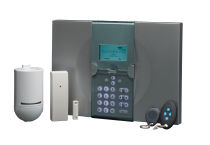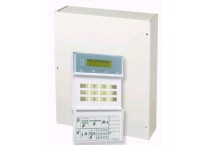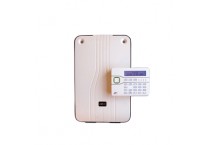What is a security system and how does it work?
All home security systems work on the same basic principle of securing entry points, like doors and windows, as well as interior space containing valuables like art, computers, guns, and coin collections. Regardless of the size of your home, or the number of doors and windows or interior rooms a homeowner decides to protect, the only real difference is in the number of security components deployed throughout the home and monitored by the control panel.
|
What is a security system? The most basic definition of any security system is found in its name. It is literally a means or method by which something is secured through a system of interworking components and devices. |
 |
Electronic alarm systems are made up of three component parts designed to detect, determine and deter criminal activity or other threatening situations. An alarm system can detect an event such as an invasion, fire, gas leak or environmental changes; determine if the event poses a threat; and then send a notification about the event.
An alarm system is probably one of the most important things you will ever buy for your home or business. Before you make this investment, there are a few things that you should know about alarm systems in general.
The following menu contains a list of what comprises a basic alarm system and a brief explanation of each of the components. However, it is not meant to infer that these components comprise complete protection. There are many more types of devices, which have not been described here, but which your local security professional will be more than happy to discuss with you. Your alarm installer will elaborate and suggest what features are available and which are appropriate for your security application.

|
Control panel This is usually a metal cabinet, which contains the electronic circuitry that regulates the functionality and communication capabilities for a security system. All detection equipment, sirens, emergency lights, and key pads within the alarm system are operated and regulated through the control panel. The control panel is usually located in an inconspicuous place within the building for added security. The alarm system control panel is the brain of the system. It carries out the decide function by processing the information it receives from various sensors and responding accordingly. For example, if a door or window is open while the system is disarmed, the control panel ignores the event. But, if a window is opened while the system is armed, it will immediately respond by sending a signal to your alarm monitoring center and triggering an audible alarm. Alarm system panels have built in communicators that transmit and receive signals via a phone line. These signals are sent to a central alarm monitoring center where trained dispatchers monitor alarm system signals. In the event of a triggered alarm, a dispatcher will contact you to verify the emergency situation and if necessary, contact the police or fire station on your behalf. An alarm panel responds to a triggered alarm by activating physical alarms such as a siren and/or strobe lights. These devices are used to scare an intruder away from your premises or alert you of a threatening situation such as a fire or the presence of carbon monoxide. The component parts of an alarm system work together to detect, determine and deter danger in your home. To ensure your equipment will function properly in the event of an emergency, it is important to conduct regular testing on your systems. Contact an ESA member company for more information. |
 |
Interior Sensors
Interior protection can consist of passive infrared units, sound sensors, stress sensors, under carpet mats, door sensors, and other such devices.These components are deliberately and specifically positioned throughout the premises, so that anyone traversing the building will be detected and changes within the interior environment affecting the detection pattern will be distinguished.
It should be noted that pets, lifestyle, business constraints, building construction, and environmental influences will need to be considered when designing effective interior protection. Your Alarm Installer will be happy to advise you as to the best application for your specific requirements.
|
Door and window sensors are comprised of two parts installed adjacent to each other. One part of the device is installed on the door or window and the other on the door frame or window sill. When a door or window is closed, the two parts of the sensor are joined together, creating a security circuit. When the security system is armed at the control panel, these sensors communicate with it by reporting that the point of entry is secure. Should a monitored door or window suddenly be opened, the security circuit is broken and the control panel interprets this as a breach of a secured zone. A high-decibel alarm is sounded and in most instances the alarm monitoring company is automatically notified. |
 |
- Motion Sensors:
 |
These security components, when armed, protect a given space by creating an invisible zone that cannot be breached without sounding an alarm. These are typically used to protect rooms containing valuables, as well as areas less frequented in larger homes. |
Depending upon the application required environmental sensors can detect: gas leaks (carbon monoxide, carbon dioxide, propane, etc.), low or high temperature conditions, high water levels, and similar conditions. Given the enormous amount of damage, and potentially life-threatening situations that environmental abnormalities can create, the use of these safeguarding devices will enchance your total alarm protection. |
 |
- Fire Sensors
 |
Most security systems also contain devices for the detection of fire conditions. Smoke detectors are most commonly used and are sensitive enough to detect the gaseous products of combustion before flames are ignited, thus affording excellent early warning protection. Other devices include: heat detectors, rate of rise detectors, sprinkler systems, Halon systems, etc. The combination of these devices will provide you with protection and advanced notification against the potentially deadly destruction of fire. |
 |
Keypad
| This device is an integral component of your alarm system and is basically used to turn the system on and off. This is accomplished by entering a pre-programmed code and/or set of commands into the keypad. The display on the keypad will show you the current status within your security system. The keypad could also enable you to control most of the functions of the alarm system within your building. And, if programmed accordingly, it can also allow you to summon police, fire, and ambulance response services. |
Audible Devices
 |
Most alarm systems have some form of alerting equipment that sounds a warning, when the security at the premises has been violated, or if a potential fire has been detected. These devices can be sirens, horns, bells, etc. and would be installed, preferably, inside of the building. They are useful in scaring away an intruder, thus making the premises safer. |  |
|
| Local regulations need to be checked before any such equipment is installed on the exterior, because some municipalities ban this application. Other communities require a maximum of fifteen minutes, automatic shut-off time on all external audible devices, so as not to create a neighborhood nuisance. High-decibel Alarm: Loud enough for neighbors to hear, home security alarms serve a few different purposes. First, they alert the people inside the house that a problem occurred. They're also shrill enough to send a burglar running while also notifying nearby neighbors |
 |
||
Panic Buttons and Medical Pendants
 |
Panic buttons can be placed strategically throughout the premises, so that you have immediate access to them in the event of an emergency condition - or, their functions can be duplicated and activated at your various keypads. Individuals also have an option to wear or carry medical pendants. When pressed, all of these devices instantly and automatically alert the Central Monitoring Station that an emergency condition exists at the premises. The Central Monitoring Station can then dispatch the appropriate authorities immediately to respond to your urgent situation. |
Perimeter Sensors
|
Sensors are placed on the outside windows and doors of the building and are designed to instantly detect unauthorized entry. They comprise the first level of defense for the security of your premises. These sensors can be magnetic door and window contacts, glass break detectors, shock sensors, screen sensors, trip wires, bars, etc. The selection of the proper device is dependent upon the construction of the premises, degree of security required, life-style of the homeowner, business requirement(s), limitation of the products available, and price. When tripped, any of these sensors are designed to electronically alert the occupants, and the Central Monitoring Station, that an unauthorized person is trying to gain access into the premises. Help would be dispatched at once by the Central Monitoring Station! |
 |
Yard Sign and Window Stickers:
 |
On the surface, these items might seem like nothing more than marketing tools for alarm companies, but they play important roles in home security. When you place a security company's sticker in a front window and plant their sign in your front yard, you are telling burglars you home is professionally protected and not a wise choice for an attempted burglary. They are effective at conveying this message and should be used as recommended by the security company. |
What Happens when an intrusion occurs?
Security systems are designed to perform certain tasks when a secured zone is breached. What your security systems does in the event of an intrusion depends on the type of system you're using.
- Professionally Monitored Security Systems:
If your security system is professionally monitored by an alarm company, they are alerted when a security problem arises in your home. Along with the high-decibel alarm that sounds, the monitoring company is alerted. A trained security expert might attempt to communicate with the homeowner via the control panel if it's setup for 2-Way Voice communication, or will call the emergency contact number listed on the account.
These types of security systems communicate with the monitoring company in one of several ways, including:
- Over existing home phone lines, which continue to work during power outages when battery backup is in use.
- Wirelessly through cellular radio frequencies like cell phones use, which also continue to work during power outages when battery backup is in use.
- Voice over Internet Protocol (VoIP), which typically doesn't work in a power outage.
- Via the Internet, which also typically does not work in a power outage.
In the event of an actual emergency, the monitoring company will notify the appropriate emergency response personnel in your area. This includes police, firefighters, and paramedics. The monitoring company will also try to maintain communication with you until emergency response teams arrive at your home.
Monitored systems typically allow for the homeowners (or designees) to be notified by text message and email when a security breach occurs.
- Non-monitored Security Systems:
There are plenty of DIY security systems available today that don't include professionally monitored services. In the event of a home intrusion when this type of security system is installed, a high-decibel alarm sounds (provided one is installed). Contacting police, fire, or other emergency response personnel must be initiated by the homeowner by dialing the appropriate number, typically 911.
These types of systems may or may not allow for text messages or email notifications to be sent to the homeowner in the event of a security breach, depending on the provider and the system you opted for.
What are the advantages of having a home security system?
Numerous studies show homes without security systems, when compared to those with professionally monitored systems, are up to three times more likely to be burglarized because burglars are opportunistic by nature and are on the hunt for easy targets.
Homes without security systems are high on their list.
When you have a home security system professionally monitored, and advertise this by displaying window stickers and yard signs, you're letting burglars know the likelihood they'll fail and be caught are very high.
Another advantage is the ability to remotely manage your house. With this, you can typically arm and disarm your security system from anywhere in the world via a web-enabled device, monitor who arrives and leaves your home, as well as use a panic button to elicit an instant response from your alarm monitoring company.
Finally, most home insurance companies provide great discounts-up to 20%-when you have a home security system in your home.
If you'd like to know more about getting a security system in your home, please contact any of our specially trained home security experts at 00357 77776020. They'll be able to answer all of your questions, help you decide which security companies and options will fit your particular needs, and help you finalize your order.









